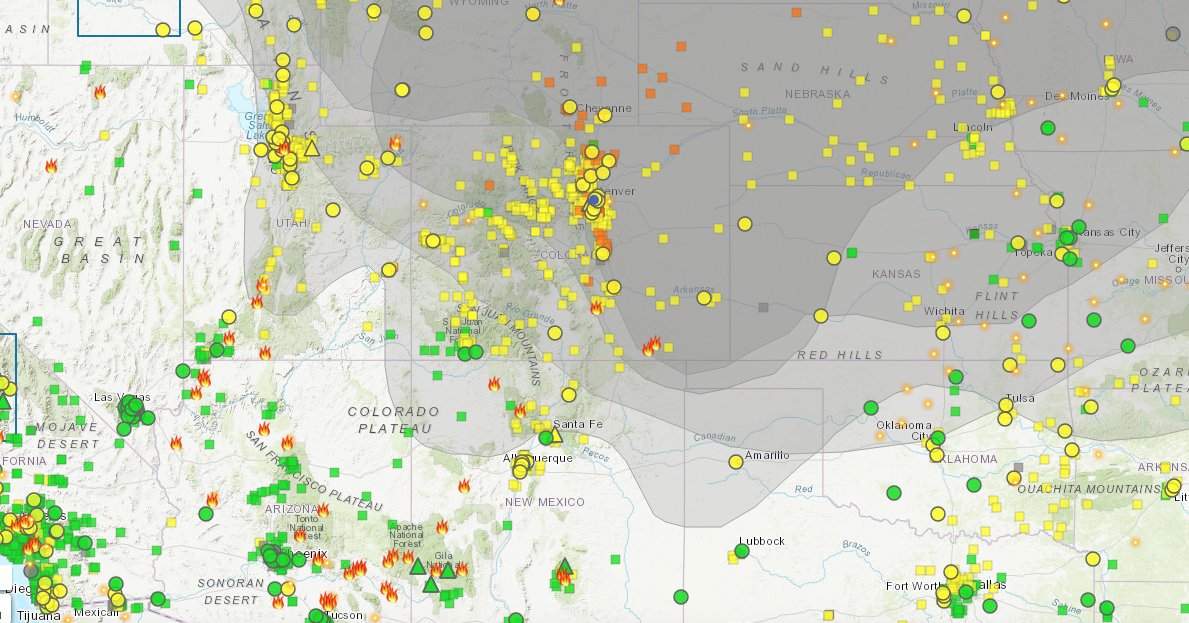DENVER — Wildfire smoke drifting from Canada and the Pacific Northwest have landed Denver and two other Colorado cities among the top five cities with the worst air quality across the U.S. on Tuesday as hazy conditions are expected to continue in the area through at least Wednesday.
The Colorado Department of Public Health and Environment (CDPHE) and the Regional Air Quality Council (RAQC) issued an ACTION DAY ALERT for the urban corridor from Douglas County north to Larimer and Weld counties, including the Denver-Boulder area, Fort Collins and Greeley on Monday after heavy wildfire smoke from the north resulted in elevated levels of both ozone and particle pollution.
The alert will remain in effect until at least 4 p.m. Tuesday, officials said.
Outside of the Front Range, the CDPHE issued an air quality health advisory for pretty much all areas east of the Continental Divide through at least 9 a.m. Wednesday, according to the National Weather Service in Boulder.

“A steady stream of smoke continues to pour into Colorado from the north. The heaviest smoke today will undoubtedly be across the eastern half of Colorado with advisories posted for all areas to the east of the Continental Divide,” an official with the CDPHE’s Air Pollution Control Division wrote Tuesday.
Though all of eastern Colorado is being impacted by the smoke Tuesday, division officials said they expected “the worst air quality to likely be across the northeastern corner of the state (including Julesburg, Fort Morgan and Burlington) westward to the Front Range foothills, including the entire Interstate 25 corridor from Ft. Collins southward through Denver and Colorado Springs to Pueblo.”
In the northeastern corner of the state, officials were anticipating the highest particle pollution due to having the highest smoke, meanwhile for those in the foothills, a combination of particle pollution and ozone will raise health concerns for sensitive groups, such as people with asthma, and the air quality “is expected to get progressively worse as we move through the day,” division officials said.
“Any outdoor activities would be best suited during the morning hours. Better yet, if possible limit your time outdoors altogether,” they wrote, advising those who can’t be inside to “slow it down and take plenty of breaks.”
To underscore just how bad the air quality is right now across in Colorado, the CDPHE’s Air Pollution Control Division shared an image taken from a webcam at Pikes Peak, showing the Eastern Plains “completely shrouded in smoke.”

By 1 p.m. Tuesday, Colorado Springs, Denver and Aurora had landed on the Top 5 places for worst air quality in the U.S., according to IQAir, with Colorado’s capital ranking among the Top 10 worst cities for bad air in the world.
Hazy/smoky conditions aren’t done with us just yet, however, as lingering smoke can’t be completely ruled out for the region, especially across the far east plains, through Wednesday night, according to NWS officials in Boulder.
Conditions get better by Friday afternoon, though, with the chance of scattered showers and thunderstorms for the high country and some high-based showers/storms extending onto the plains.
“Saturday will feature afternoon low coverage showers and storms. These two days will feature the ‘highest’ chances for precipitation,” weather service officials said.
Watch Denver7's 24/7 weather stream in the video player below.



